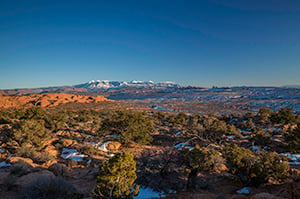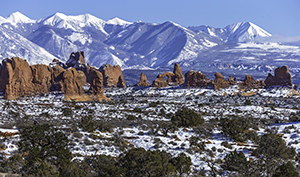Using a telephoto lens for a landscape sounds kind of odd, right? Most people think of a telephoto or zoom-telephoto lens as good for wildlife and sports images, not landscapes, per se.
One evening, though, while running a Google search, I landed upon a short blog, the subject of which centered upon telephoto lens use for landscape photos. Sure, I know this is not a novel idea. But honestly, I hadn’t given much thought to using any lenses except my Canon 16-35mm and Canon 24-70mm for the images I planned on capturing during my eight-day trip to Arches National Park last month.
I still intended to take my Canon 70-200mm, but I figured that lens would see little use. I didn’t expect to see much in the way of wildlife except for a few deer and ravens. There are about 50 Desert Bighorn sheep in the park, but I highly doubted I would spot any (I didn’t). February is a little chilly for snakes or other reptiles to make an appearance and I was pretty certain I wouldn’t see any scorpions. In the end, I only saw three deer total, and very few ravens, (although I often heard their gravelly caw at great distance high above in the red rock formations).
After reading that little blog, I changed my mind about minimal use of that 70-200 zoom. I’d take it with me and make a point to use it as much as I would my other lenses, thinking this might make for a good National Parks Traveler column (grin). As a matter of fact, I ultimately used that telephoto as much, if not more, than my wide-angle lenses!
Wide-Angle vs. Telephoto Scenes – A Comparison
By definition, “wide angle” refers to anything from 8mm to 35mm (although 8mm up to 17mm is more in what some would call the “ultra wide-angle” category).

A wide-angle view of the La Sal Moutains, the Windows section, and landscapes in between. Rebecca Latson photo.
Now, how many of you have encountered an incredible panoramic vista within a national park, the dramatic essence of which you felt you didn’t (successfully) capture in total with your widest lens?
I personally feel pretty frustrated when something like that happens. I can take the picture, but the end result is less than what I imagined. Wide-angle lenses are awesome, but by their very nature, these lenses tend to make that glorious panoramic vista look small and much further away (sort of like those side view mirrors on your car that say “object in mirror is closer than it appears”).
What the eye sees sometimes cannot be successfully conveyed, in whole, onto digital or film format with a wide-angle lens. Mind you, I LOVE my 16-35mm lens and really like the look that an ultra-wide angle lends to a scene. However, I also understand that this type of lens can, at times, minimize that awe-inspiring impact I want to convey to my viewer when they behold an image of an unbelievable scene in the park.

A wide-angle shot of the late afternoon sun on the La Sal Range. Rebecca Latson photo.
I certainly found that to be true as I stood at one of my favorite viewpoints (the La Sal Mountain Viewpoint near the entrance to the park). Of course I used my wide-angle lenses, but I also used my 70-200 at its longest focal lengths (100 – 200mm) to capture a different facet of the same scene. Take a look at the comparison photos (left and below) and tell me which image you think has more impact. What image makes more of an impression on you?
Ok, I’ll own that it’s subjective and you may like the other image better than the one with which I am trying to prove a point. Nonetheless, while the telephoto may not capture as much of the vista as the wide-angle, does it have any less impact because of this? It still makes a pretty good landscape scene, I think.

Zoom view of late afternoon image of La Sal Mountains. Rebecca Latson pho
The secret to capturing an inspiring landscape using a telephoto or zoom-telephoto lens is learning how to choose your composition for the maximum effect and greatest interest. Zoom in and place your focus on whatever part of the image you think has the best/most color, drama, texture, pattern, or lighting.
Also, think about choosing your scene that best reflects some character or aspect of the park. For instance, take a look at the three compositions you see below with Balanced Rock in the foreground and the Windows section of the park and the La Sal Mountains in the background.
For these images, I waited until late afternoon for the best light and color. You can see that the wide-angle image captures everything. So, for the telephoto images, I wanted to keep either Balanced Rock and/or Turret Arch in the image because they are both recognizable and representative of Arches National Park.

A wide-angle view of Balanced Rock, the Windows section, and the La Sal Mountains. Rebecca Latson photo.
Take a closer at that final image in this series of three. Telephoto and zoom-telephoto lenses have the interesting ability to compress distances between objects, so that something miles away from the subject of your image looks like it is instead literally a few hundred feet away. This is why the La Sal Mountains appear to be looming over the red-rock Turret Arch and the other Windows formations in this composition.

A zoomed view of the same landscape. Rebecca Latson photo.
Consider this yet another method of adding some interest to your landscapes when using this type of lens.
While you may not be totally convinced about the advantage of utilizing a telephoto lens over that of a wide-angle lens, I would nonetheless suggest that you try your hand at capturing photos of the same scene using both types of lenses. Because of the different focal lengths, you will get in some practice at choosing how to compose your scene for the maximum effect, both wide-angle and close-in. While you may feel less experienced using one lens or focal length over the other, it certainly never hurts to go out of your comfort zone just a little bit. That’s part of the fun of photography!

An ultra-zoomed view of the same image, only this time highlighting Turret Arch. Rebecca Latson photo
On a separate note, if you are planning on visiting Arches National Park, here’s some lighting advice for you. As you drive along the main paved road heading into the park, your best morning images will be on the left side of the road, while your best afternoon images will be on the right side of the road. For the most part. This is not set in stone, but it is a good rule of thumb.
Now, get out into a park with your telephoto or zoom-telephoto lens, and get some great landscapes!


 Support Essential Coverage of Essential Places
Support Essential Coverage of Essential Places







Comments
Love, Love, Love this input. Annually there is a photography contest in which you submit a National Park based image for the picture on the National Park Annual Pass. In Moab Utah, over twenty Photography Workshops will be held in 2013, many are permitted to enter Arches and Canyonlands National Parks. Please open the link to view this list of 2013 Moab Utah Photography Workshops. Tune up photography skills with like minded people.